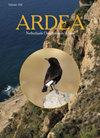荷兰加勒比海萨巴岛红嘴热带鸟类早期饲养期间的觅食生态
IF 1.3
4区 生物学
Q3 ORNITHOLOGY
引用次数: 1
摘要
贫营养热带海洋环境中的猎物资源往往是分散的和不可预测的。对热带海鸟的跟踪研究可以提供有关海洋栖息地亲和力、猎物选择和周围区域利用的关键信息,这对保护管理人员很有用。对加勒比地区红嘴热带鸟种群的觅食研究很少,但正在增加。我们试图通过使用GPS设备跟踪养鸡的成年鸟,并随后将这些跟踪数据与遥感环境变量联系起来,以此来扩展这一点。我们将我们的空间数据与荷兰加勒比海萨巴岛一个全球重要的筑巢群的反刍物机会抽样联系起来。饵料以飞鱼科为主;数值频率:70.73%),但猎物来自鱿鱼科(Loliginidae;9.76%)和飞蝇科(趾翅科;2.44%),鳐鱼科;2.44%)也被鉴定出来,但由于消化,我们无法鉴定14.63%的样品。我们研究的另一个目标是比较萨巴岛上的热带鸟类与东南约25公里处的圣尤斯特歇斯岛上筑巢的热带鸟类的觅食生态。结果表明,在沙巴岛筑巢的热带鸟类表现出日觅食模式,最大迁徙距离为553.7 km,平均迁徙距离为117.2±144.6 km(±SD)。与旅行点相比,成虫在较浅、较冷的水域觅食,叶绿素a浓度较高,外cotidae物种丰富度较高。尽管萨巴岛和圣尤斯特歇斯岛邻近,但这与在圣尤斯特歇斯岛上筑巢的热带鸟的情况相反,那里的成鸟在较深的水域觅食,外cotidae物种丰富度较低。然而,来自萨巴岛和圣尤斯特歇斯岛的热带鸟在觅食行为上确实表现出一些相似之处;具体来说,觅食的成虫穿越了多个专属经济区和海洋保护区,这加强了我们对加勒比地区自然管理者的建议,即建立一个跨界网络,以有效地保护和养护这一物种。本文章由计算机程序翻译,如有差异,请以英文原文为准。
Foraging Ecology of Red-Billed Tropicbirds on Saba, Caribbean Netherlands, during Early Chick-Rearing
Prey resources in oligotrophic tropical marine environments are often scattered and unpredictable. Tracking studies of tropical seabirds can provide critical information about ocean habitat affinities, prey choice and the utilisation of surrounding areas, which can be useful for conservation managers. Foraging studies of Red-billed Tropicbird populations in the Caribbean are scarce but increasing. We sought to expand on this by tracking chick-rearing adults using GPS devices and subsequently linking these tracking data to remotely-sensed environmental variables. We related our spatial data to opportunistic sampling of regurgitates in a globally significant nesting colony on Saba, Caribbean Netherlands. Diet samples were dominated by flying fish (Exocoetidae; numerical frequency: 70.73%), but prey items from the squid family (Loliginidae; 9.76%) and the families of flying gurnards (Dactylopteridae; 2.44%) and the ray-finned fish (Carangidae; 2.44%) were also identified, although we were unable to identify 14.63% of samples due to digestion. An additional goal of our study was to compare the foraging ecology of Tropicbirds on Saba with those nesting on St. Eustatius, located circa 25 km south-east. As expected, Tropicbirds nesting on Saba exhibited diurnal foraging patterns, travelling a maximum distance from the colony of 553.7 km, with an average trip length of 117.2 ± 144.6 km (±SD). Adults foraged in shallower, cooler waters with higher chlorophyll a concentrations and higher Exocoetidae species richness compared to travelling points. Despite the proximity of Saba and St. Eustatius, this is contrary to what was found for Tropicbirds nesting on St. Eustatius, where adults foraged in deeper waters with a low Exocoetidae species richness. However, Tropicbirds from Saba and St. Eustatius did exhibit some similarities in their foraging behaviour; specifically, foraging adults traversed multiple exclusive economic zones and marine protected areas, reinforcing our recommendation for nature managers in the Caribbean to create a transboundary network in order to effectively protect and conserve this species.
求助全文
通过发布文献求助,成功后即可免费获取论文全文。
去求助
来源期刊

Ardea
生物-鸟类学
CiteScore
2.10
自引率
0.00%
发文量
49
审稿时长
>12 weeks
期刊介绍:
Ardea is the scientific journal of the Netherlands Ornithologists'' Union, and is published since 1912. The journal welcomes manuscripts reporting significant new findings in ornithology, in particular those covering the ecology, life history, and evolution of birds, and including sound descriptive work. Ardea publishes Original research papers, Short notes and Book reviews. In addition to the regular three issues per year, Ardea publishes specials that contain conference or workshop proceedings (produced on request).
 求助内容:
求助内容: 应助结果提醒方式:
应助结果提醒方式:


